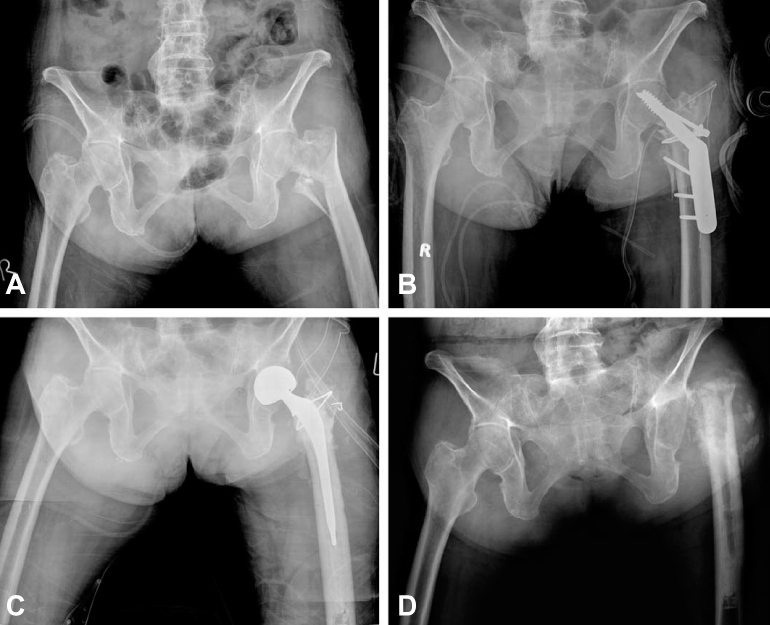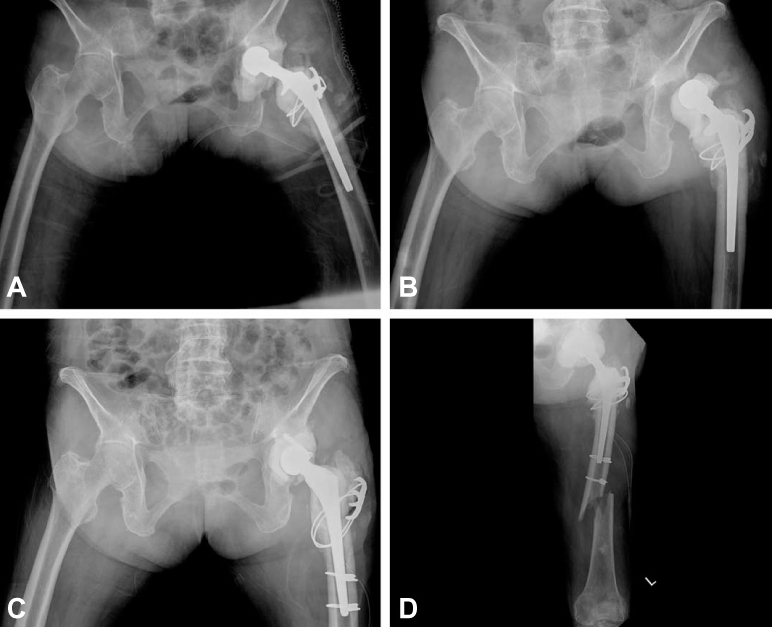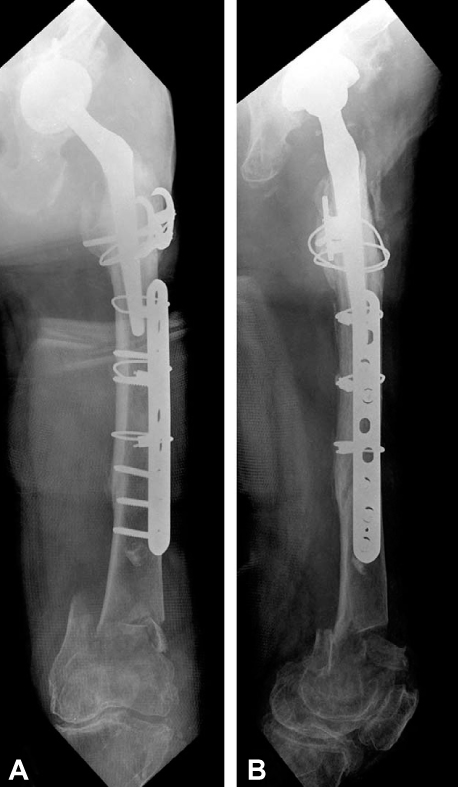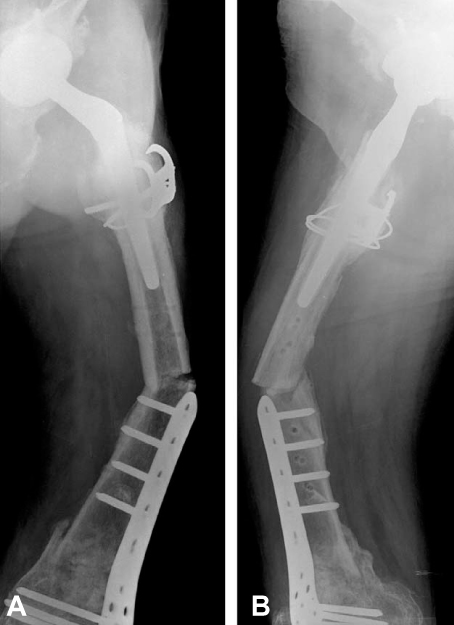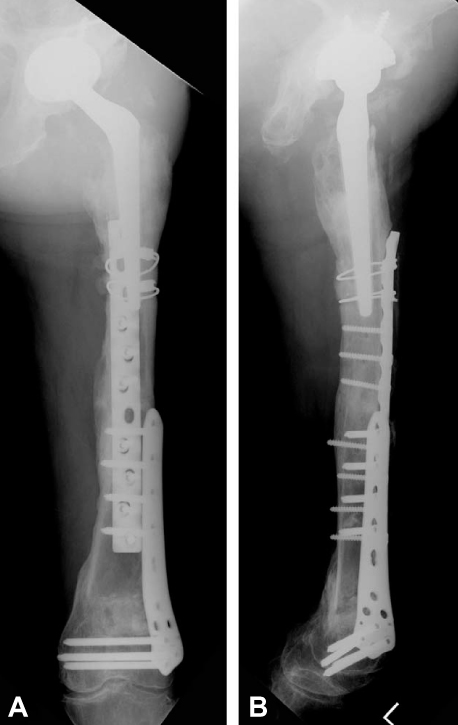J Korean Hip Soc.
2011 Mar;23(1):66-71. 10.5371/jkhs.2011.23.1.66.
Surgical Management of Repeated Low-Energy Periprosthetic Femur Fractures: A Case Report
- Affiliations
-
- 1Department of Orthopaedic Surgery, Chonnam National University Hwasun Hospital, College of Medicine, Chonnam National University, Jeonnam, Korea. chiasma@hanmail.net
- KMID: 2190778
- DOI: http://doi.org/10.5371/jkhs.2011.23.1.66
Abstract
- Periprosthetic fracture of the femur is an uncommon complication after total hip arthroplasty (THA), but it appears to be increasing in incidence as a result of the aging population demographics and the increased number of THAs that are being performed. Much interest has been generated regarding low energy fractures in the elderly, but repeated periprosthetic fractures in the same femur are uncommon. The authors present here the case of a 71 year old patient who sustained repeated low energy ipsilateral periprosthetic femur fractures. The initial injury was caused by a road traffic accident, but the subsequent fractures were all caused by low energy falls. The patient sustained proximal and distal femur fractures with implants in situ. The probable causes of such fractures was a combination of systemic and local host factors, such as osteoporosis, cortical stress risers, local osteopenia secondary to bed rest, quiescent infection and altered fracture site vascularity due to the internal fixation devices and multiple re-operations.
MeSH Terms
Figure
Reference
-
1. Salminen S, Pihlajamäki H, Avikainen V, Kyrö A, Bostman O. Specific features associated with femoral shaft fractures caused by low-energy trauma. J Trauma. 1997. 43:117–122.
Article2. Duncan CP, Masri BA. Fractures of the femur after hip replacement. Instr Course Lect. 1995. 44:293–304.3. Kavanagh BF. Femoral fractures associated with total hip arthroplasty. Orthop Clin North Am. 1992. 23:249–257.
Article4. Ahuja S, Chatterji S. The Mennen femoral plate for fixation of periprosthetic femoral fractures following hip arthroplasty. Injury. 2002. 33:47–50.
Article5. Serocki JH, Chandler RW, Dorr LD. Treatment of fractures about hip prostheses with compression plating. J Arthroplasty. 1992. 7:129–135.
Article6. Garcia-Cimbrelo E, Munuera L, Gil-Garay E. Femoral shaft fractures after cemented total hip arthroplasty. Int Orthop. 1992. 16:97–100.
Article7. Bethea JS 3rd, DeAndrade JR, Fleming LL, Lindenbaum SD, Welch RB. Proximal femoral fractures following total hip arthroplasty. Clin Orthop Relat Res. 1982. 170:95–106.
Article8. Hidaka S, Gustilo RB. Refracture of bones of the forearm after plate removal. J Bone Joint Surg Am. 1984. 66:1241–1243.
Article9. Haidukewych GJ. Innovations in locking plate technology. J Am Acad Orthop Surg. 2004. 12:205–212.
Article10. Tadross TS, Nanu AM, Buchanan MJ, Checketts RG. Dall-Miles plating for periprosthetic B1 fractures of the femur. J Arthroplasty. 2000. 15:47–51.
Article
- Full Text Links
- Actions
-
Cited
- CITED
-
- Close
- Share
- Similar articles
-
- Periprosthetic Atypical Femoral Fracture-like Fracture after Hip Arthroplasty: A Report of Three Cases
- Periprosthetic Femur Fracture due to Unrecognized Surgical Instrument Left in the Medullary Canal : A case report
- Treatment of Periprosthetic Femoral Fractures after Hip Arthroplasty
- Fractures of the Femur associated with the Hip Arthroplasty
- Femoral Periprosthetic Fractures after Total Knee Arthroplasty: New Surgically Oriented Classification with a Review of Current Treatments

